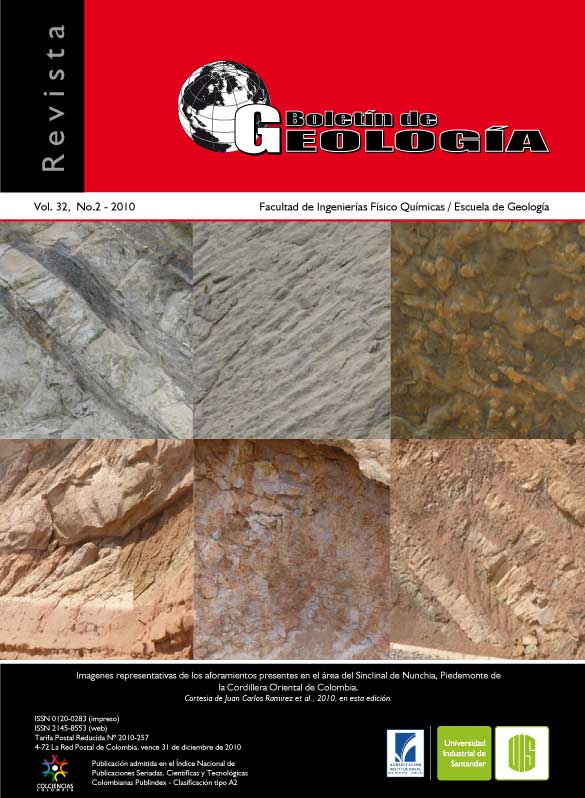PETROGRAFÍA Y GEOQUÍMICA DE LOS METAGABROS DEL RÍO OLIVARES SECTOR NNW DE MANIZALES (CALDAS)
Published 2011-08-08
How to Cite
Abstract
The Río Olivares Metagabbro is a body of igneous intrusive rocks that outcrops along the Río Olivares at N–NWof the Manizales city (department of Caldas, Colombia). This igneous body is defined by series of centimeterto metric-sized faulted slivers within the western sector of Quebradagrande Complex. Petrographic analyses show rocks with cumulus and isotropic gabbroic textures. The primary minerals are: calcium plagioclase andclinopyroxene, secondary minerals are: amphibole, chlorite, epidote, plagioclase and less quartz, carbonateand occasionally opaque minerals. According to geochemical distribution of major elements, those rocks were generated from fractional crystallization of unique magma showing a typical tendency of tholeiitic series.Taking into account the behavior of trace elements in geotectonic discrimination diagrams, they were generated in an ocean floor setting and their sources coming from an N-MORB segment in the upper mantle. REE patterns normalized with respect to chondrite, show relatively homogeneous patterns, flats and enriched up to 10 times compared to the typical N-MORB. These rocks are part of the oceanic basement of the Early Cretaceous Quebradagrande Complex, and they are affected by my lonitization and ocean floor metamorphism.
Key words: Manizales, metagabbros, N–MORB.
Downloads
References
Cabanis, B., and Lecolle, M. 1989. Le diagramme La/10–Y/15–Nb/8: un outil pour la discrimination des series vocaniques et mise en evidence des processus de mélange et/ou de contamination crustale. C.R.Academic. Science. S.II,309: 2023–2029.
Calle, B., González, H., De Peña R., Escorce, E., y Durango, J. 1980. Mapa Geológico preliminar de la Plancha 166 Jericó. Escala 1:100.000. Ingeominas. Bogotá.
Condie, K.C. 1994. Greenstones through time. In K.C. Condie (ed.). Archean Crustal Evolution. Elsevier, Amsterdam, pp. 85–120.
Condie, K. C. 1999. Mafic crustal xenoliths and the origin of the lower continental crust. Lithos, 46: 95–115.
González, H. 2001. Geología de las Planchas 206 Manizales 225 Nevado del Ruíz a escala 1:100.000. Memoria explicativa. Ingeominas, Bogotá.
González, H., Agudelo, S., y Calle, B. 1980a. Mapa geológico de la Plancha 187 (Salamina). Escala 1:100.000 Ingeominas, Bogotá.
Hincapié, J, G., Toro, T., L.M., y Ossa, M., C.A. 2010. Análisis cinemático y deformativo de los Metagabros del Río Olivares. En preparación.Irvine, T.N., and Baragar, W., R.A. 1971. A guide to the chemical classification of the common volcanic rock. Canadian Journal of Earth Science, 8: pp. 523–548
Jenner, G.A. 1996. Trace element geochemistry of igneous rocks: Geochemical nomenclature and analytical geochemistry. In Wyman, D.A., ed., Trace Element Geochemistry of Volcanic Rocks: Applications For Massive Sulphide Exploration: Geological Association of Canada, Short Course Notes, 12: pp. 51–77.
Kretz, R. 1983. Symbols for rock–forming minerals. American Mineralogist, 68: pp. 277–279.McLean, W.H., Barrett, T.J. 1993. Lithogeochemical techniques using immobile elements. Journal of Geochemical Exploration 48: pp.109–133.
Mejía, M., Álvarez, E. y González, H. 1983a. Mapa geológico preliminar de la Plancha 130 (Santafé de Antioquia). Escala 1:100.000, Ingeominas.
Sibson, R.H. 1977. Fault rocks and fault mechanisms. Journal of the Geological Society, London, 133: pp. 191–213.Su, Y., and Langmuir, C. H. 2003.
Global MORB chemistry compilation at the segment scale, MS Thesis, Department of Earth and Environmental Sciences, Columbia University. En: http://petdb.ldeo.columbia.edu/documentation/morbcompilation/.
Sun, S.S., and McDonough, W.F. 1989. Chemical and isotopic systematics of oceanic basalts: implications for mantle composition and processes. In Sanders A.D. and Norry, M.J. (eds), Magmatism in ocean basins. Geological Society. London. Spec. Pub. 42: pp. 313–345
